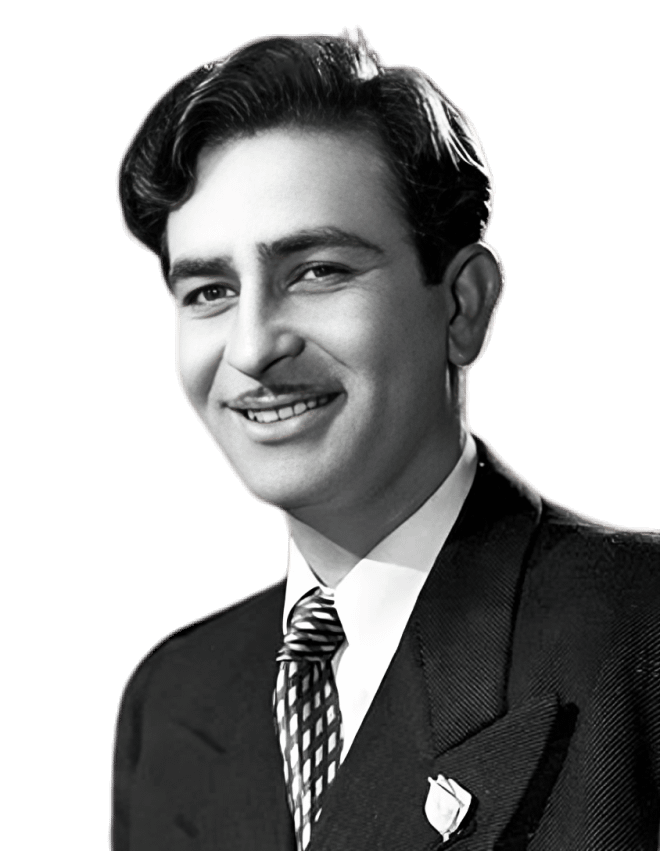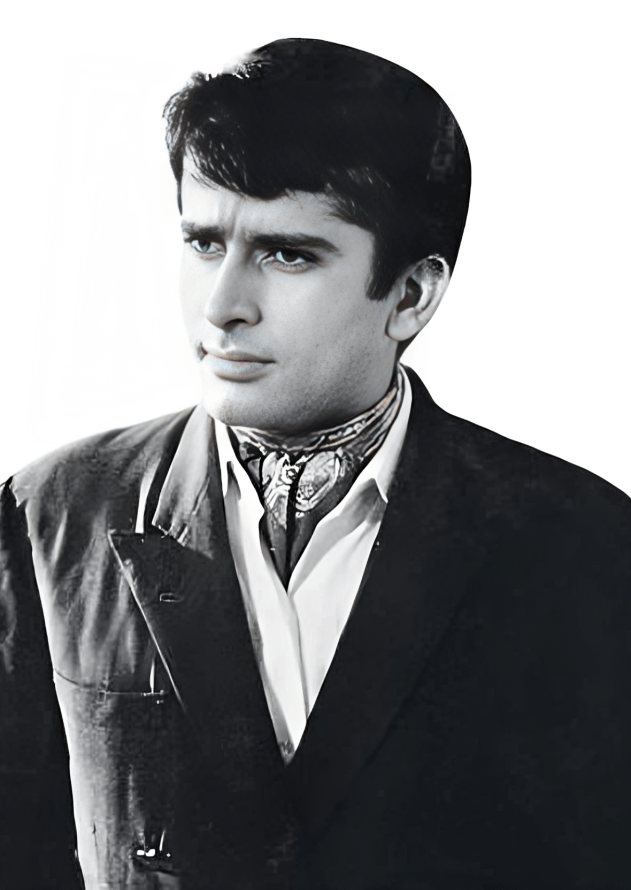Raj Kapoor Indian Actor and Film Director Introduction

Raj Kapoor, often revered as “The Showman of Indian Cinema,” is one of the most iconic figures in the history of Indian film. Born into a family deeply rooted in the performing arts, Kapoor carved a unique place for himself with his immense contributions as an actor, director, and producer. His films, filled with romance, social commentary, and musical brilliance, became the cornerstone of popular Hindi cinema and inspired generations of filmmakers across the globe. Through his film banner R.K. Films, he not only created some of the most unforgettable cinematic experiences but also brought Indian cinema to international audiences.
Raj Kapoor Early Life and Background
Raj Kapoor was born as Ranbir Raj Kapoor on December 14, 1924, in Peshawar, British India (now in Pakistan), into a Kashmiri Hindu family. He was the eldest son of Prithviraj Kapoor, a respected theater and film actor, and Rama Kapoor. His brothers, Shammi Kapoor and Shashi Kapoor, also became renowned actors, making the Kapoor family a cornerstone of Indian film legacy.
Growing up in a theatrical household, Kapoor was exposed to the arts from a young age. He studied at several schools, including Colonel Brown Cambridge School in Dehradun and St. Xavier’s Collegiate School in Kolkata, but he was never particularly academically inclined. His heart lay in cinema.
Raj Kapoor Entry into Films
Kapoor began his career in the film industry at the tender age of 10, playing a small role in the 1935 film “Inquilab”. However, his first major role as a lead actor came in “Neel Kamal” (1947), opposite Madhubala, directed by Kidar Sharma. His expressive face, romantic charm, and soulful eyes quickly caught the attention of the audience.
At just 24 years of age, he became the youngest director of his time when he founded R.K. Films in 1948 and made his directorial debut with “Aag”, which, although not a commercial success, showcased Kapoor’s ambition to create meaningful cinema. His follow-up, “Barsaat” (1949), co-starring Nargis, was a massive hit and catapulted him into stardom.
Golden Era and Cinematic Legacy
The 1950s to the 1970s are considered the golden period of Raj Kapoor’s career. He made a string of successful films that combined entertainment with social commentary. He frequently explored themes of poverty, class disparity, and the aspirations of the common man, often presenting his own persona as the ‘tramp’ inspired by Charlie Chaplin.
Awaara (1951)
One of his earliest and most influential films, Awaara, was both a domestic and international success, especially in the Soviet Union, the Middle East, and parts of Asia. The story revolved around the impact of environment and upbringing on an individual’s moral compass. The song “Awaara Hoon” became an anthem and is still remembered as one of the most iconic Hindi songs.
Shree 420 (1955)
Another masterpiece, Shree 420, further established his Chaplinesque image. The film was a satirical take on corruption and inequality in Indian society. The title song “Mera Joota Hai Japani” became a symbol of national pride and cosmopolitan identity. Kapoor’s simple yet profound messaging struck a chord with the masses.
Jagte Raho (1956)
In Jagte Raho, Kapoor took on a more serious tone, playing a poor villager trying to quench his thirst in the big city, only to encounter suspicion and alienation. The film won several awards and is still hailed for its stark depiction of urban loneliness.
Other Major Works
Kapoor continued to create memorable films like Chhalia (1960), Jis Desh Mein Ganga Behti Hai (1960), and Sangam (1964). Sangam was especially notable as Kapoor’s first film in color and was a box office sensation. The love triangle involving Kapoor, Vyjayanthimala, and Rajendra Kumar became iconic.
R.K. Films and the Kapoor Banner
Raj Kapoor’s production house, R.K. Films, became synonymous with quality filmmaking. The banner’s logo—featuring the iconic image of Kapoor holding a violin from Barsaat—became a symbol of cinematic excellence. R.K. Studios in Chembur, Mumbai, was a landmark of Indian cinema until it was damaged by fire in 2017 and later sold.
Under the R.K. banner, Kapoor nurtured talent, mentored actors, and brought Indian cinema closer to the themes of realism and romance. His films combined beautiful storytelling with melodious music, often composed by Shankar-Jaikishan and sung by legendary voices like Mukesh and Lata Mangeshkar.
Partnership with Nargis
One of the most celebrated collaborations in Hindi cinema was between Raj Kapoor and actress Nargis. Their on-screen chemistry was electric, and they worked together in films like Barsaat, Awaara, Shree 420, and Chori Chori. Off-screen, their relationship was the subject of much speculation and remains a legendary love story in the annals of Bollywood, though Nargis later married Sunil Dutt.
Later Years and Changing Times
As the cinematic landscape evolved, Kapoor struggled to maintain the same level of success. However, he continued experimenting with themes and visuals.
Mera Naam Joker (1970)
A deeply personal film, Mera Naam Joker was Kapoor’s magnum opus. The story of a clown who hides his pain behind a smile was semi-autobiographical and involved several chapters depicting different phases of the character’s life. Despite its rich emotional and visual narrative, the film was a box-office failure at the time, though it gained cult status in later years.
Bobby (1973)
To recover from the losses of Mera Naam Joker, Kapoor launched his son Rishi Kapoor in Bobby, opposite newcomer Dimple Kapadia. The film, a youthful romance with rich musical score, became a super hit and redefined Bollywood teen love stories.
Satyam Shivam Sundaram (1978), Prem Rog (1982), and Ram Teri Ganga Maili (1985)
In his later directorial works, Kapoor dealt with themes of beauty, societal taboos, and morality. Satyam Shivam Sundaram stirred controversy for its sensual portrayal of love and beauty. Prem Rog addressed widow remarriage and was critically acclaimed. Ram Teri Ganga Maili, his last directorial venture, marked the debut of actress Mandakini and became a major commercial success, though it was also criticized for its bold scenes.
Family and Personal Life
Raj Kapoor married Krishna Malhotra, a distant relative, in 1946. Together they had five children: sons Randhir Kapoor, Rishi Kapoor, and Rajiv Kapoor, and daughters Ritu Nanda and Rima Jain. The Kapoor family has remained influential in Bollywood, with grandchildren like Karisma Kapoor, Kareena Kapoor Khan, and Ranbir Kapoor continuing the legacy.
Though devoted to his family, Kapoor was known for his passionate affairs, most notably with Nargis. He was a deeply emotional person, and his films often mirrored his personal struggles, longings, and ideologies.
Recognition and Awards
Raj Kapoor received numerous awards and honors throughout his life and posthumously:
- Padma Bhushan (1971) by the Government of India.
- Dadasaheb Phalke Award (1987), India’s highest cinematic honor.
- Numerous Filmfare Awards for acting and direction.
- Honored at international film festivals in Cannes, Karlovy Vary, and Moscow.
- Hailed as the “Clark Gable of Indian cinema” by Western media.
He was admired globally, especially in Russia, China, and Eastern Europe, where his films were seen as a cultural bridge.
Death and Legacy
Raj Kapoor passed away on June 2, 1988, at the age of 63 due to complications from asthma during the 35th National Film Awards ceremony, where he was to receive the Dadasaheb Phalke Award. His death marked the end of an era in Indian cinema.
Despite his passing, Raj Kapoor’s influence lives on. His films continue to be studied in film schools, remade, and celebrated by audiences old and new. Directors like Rajkumar Hirani, Imtiaz Ali, and Sanjay Leela Bhansali have acknowledged Kapoor’s impact on their storytelling. His use of music, metaphor, and melodrama set a precedent for what we now recognize as classic Bollywood style.
Conclusion
Raj Kapoor was much more than an actor or filmmaker—he was a visionary, a dreamer, and a storyteller par excellence. His films transcended borders, languages, and generations, speaking to the universal human emotions of love, struggle, hope, and despair. His blend of artistic innovation and mass appeal created a cinematic language that still resonates today.
The world may remember him for his trademark floppy cap, walking stick, and Chaplin-esque persona, but Raj Kapoor was, above all, a master craftsman who gave Indian cinema its soul. He truly earned the title of The Showman—a legend who turned celluloid into poetry.




7 thoughts on “Raj Kapoor: The Showman of Indian Cinema”